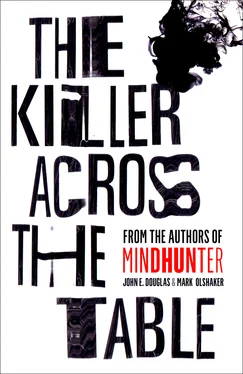Detroit was a tough city, and while I was there they were racking up as many as five bank robberies a day. Robbing a bank backed by the Federal Deposit Insurance Corporation is a federal crime, so the bureau had jurisdiction, and many new agents were assigned to investigate these cases in addition to their other duties. As soon as we would apprehend a suspect and read him his Miranda rights, often in the back of a bureau car or police cruiser, I would pepper him with questions. Why rob a bank where the security is tight, and everything is recorded on tape, rather than a store that does a large cash business? Why this particular bank branch? Why this particular day and time? Was the robbery planned or spontaneous? Did you surveil the bank first and/or make a practice run inside? I began mentally cataloging the responses and developing informal “profiles” (though we didn’t use that term yet) of bank robber types. I started seeing the differences between planned and unplanned crimes and organized and disorganized ones.
We got to the point where we could begin predicting which bank locations were most likely to be hit and when. In areas with a lot of building going on, for instance, we learned that Friday late morning was a likely time to hit the bank, because it would have a lot of cash on hand to handle the construction workers’ paychecks. We used this kind of intelligence to harden certain targets and be waiting at others if we thought we had a reasonable chance of catching robbers in the act.
During my second bureau posting in Milwaukee, I was sent to the new, modern FBI Academy in Quantico, Virginia, for a two-week in-service course in hostage negotiation. It was taught by Special Agents Howard Teten and Patrick Mullany, the original champions of behavioral science in the bureau. Their main course was called Applied Criminology. It was an attempt to bring the academic discipline of abnormal psychology into crime analysis and the training of new agents. Mullany saw hostage negotiation as the first practical use of the applied psychology program. This was a new wave in the battle against a new era of crime that involved airplane skyjackings and bank robberies with hostages, such as the 1972 Brooklyn bank heist that inspired the Al Pacino film Dog Day Afternoon. It was easy to see how having some idea of what was going on in the hostage-taker’s head would be of great benefit to the negotiator and ultimately save lives. I was one of about fifty special agents in this class, taught for the first time and a daring experiment in FBI training. Legendary director J. Edgar Hoover had died just three years before, and his lengthened shadow still hung over the bureau.
Even in his declining years, Hoover maintained an iron grip on the agency he had essentially created. His hard-nosed, hard-ass approach to investigation echoed the old Dragnet TV show line: Just the facts, ma’am. Everything had to be measurable and quantifiable—how many arrests, how many convictions, how many cases closed. He never would have embraced anything as impressionistic, inductive, and “touchy-feely” as behavioral science. In fact, he would have considered it a contradiction in terms.
While attending the hostage negotiation course at the FBI Academy, my name got around the Behavioral Science Unit, and before I left to go back to Milwaukee, I was offered positions in both the Education and Behavioral Science Units as my next posting. Even though our unit was called Behavioral Science, the primary responsibility of its nine agents was teaching. Courses included Applied Criminal Psychology, Hostage Negotiation, Practical Police Problems, Police Stress Management, and Sex Crimes, which was later changed by my great colleague Roy Hazelwood to Interpersonal Violence.
Though the academy’s “three-legged stool” model of teaching, research, and consultation was beginning to take shape, any case consultation that star agents like Teten provided was strictly informal and not part of any organized program. The focus of these forty hours of classroom instruction was supposed to be on the issue of most concern to criminal investigators: Motive. Why do offenders do the things they do, in what ways do they do them, and how can understanding this help catch them? The problem with this approach was that most of the content still came from the academic sphere, which became evident whenever senior law enforcement personnel going through the National Academy program had more firsthand case experience than the instructors.
No one was more vulnerable in this area than the youngest instructor on the team: me. Here I was standing in front of a classroom full of seasoned detectives and officers, most of them a lot older than me. And I was supposed to teach them what was going on in the criminal mind, something they’d actually be able to use to help clear cases. Most of my firsthand experience had come from working with experienced cops and homicide detectives in Detroit and Milwaukee, so it seemed presumptuous of me to be telling men like that their own business.
There was a dawning realization among many of us that what was applicable to the psychiatric and mental health community had only limited relevance to law enforcement.
Still, I started getting the same types of requests Teten got. In class or during breaks, or even in the evenings, officers and detectives would come up and ask for pointers or advice on their active cases. If I was teaching a case similar in some way to one they were working on, they would figure I could help them solve it. They saw me as the authoritative voice of the Federal Bureau of Investigation. But was I? There had to be a more practical way to amass useful data and case studies that would give me the confidence to feel I really knew what I was talking about.
As the guy closest to me in age, Robert Ressler was tapped to help me break into the academy culture and feel comfortable with teaching. About eight years older than I was, Bob was a new instructor who built on what Teten and Mullany had done, aiming to bring the discipline of behavioral analysis closer to something that could be of value to police departments and criminal investigators. The most efficient way to give a new instructor some concentrated experience was through what we called road schools. Instructors from Quantico would spend a week teaching a selective piece, sort of a highlights version, of the National Academy curriculum to a police department or law enforcement agency that had requested it, then move on to another for a second week before returning home with the memories of interchangeable hotel rooms and a suitcase full of dirty laundry. So Bob and I hit the road together.
One morning early in 1978, Bob and I were driving out of Sacramento, California, the site of our latest road school. I commented that most of the criminals we were teaching about were still around, we could easily find out where they were, and they weren’t going anywhere. Why not see if we could meet and talk with some of them, find out what a crime was like through their eyes, get them to recall and tell us why they did what they did and what was going on in their minds when they did it. I figured it didn’t hurt to try, and some of them might be bored enough with their prison routines that they’d welcome a chance to talk about themselves.
Very little research was available relative to interviewing prison inmates, and what there was pertained specifically to convictions, probation and parole, and rehabilitation. However, the record seemed to indicate that violent and narcissistic inmates, on the whole, were incorrigible—meaning they were not able to be controlled, improved, or reformed. By talking to them, we hoped to learn if this was indeed the case.
Bob was initially skeptical, but willing to go along with this crazy idea. He’d served in the army, and between the army and the bureau, he’d had enough experience with bureaucracies that his mantra was “It’s better to ask for forgiveness than permission.” We would show up unannounced. In those days FBI credentials could get us into prisons without prior permission. If we had said in advance that we were coming, there was a danger word would leak out into the yard. And if an inmate was known to be planning to speak with a couple of feds, the rest of the prison population might think he was a snitch.
Читать дальше












